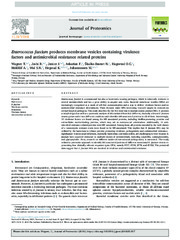| dc.contributor.advisor | Hegstad, Kristin | |
| dc.contributor.author | Wagner, Theresa | |
| dc.date.accessioned | 2018-11-06T18:11:10Z | |
| dc.date.available | 2018-11-06T18:11:10Z | |
| dc.date.issued | 2018-10-18 | |
| dc.description.abstract | Enterococcus faecium is a ubiquitous bacterium that only recently emerged as a nosocomial pathogen. Infections mostly affect immunocompromised patients and multi-resistance of E. faecium often hampers treatment. This thesis focuses on determinants, which give pathogenic potential to E. faecium.
In the first paper, two TirE proteins are described as novel virulence factors of E. faecium. The tirE encoding genes are exclusive to nosocomial E. faecium strains and localized on a putative mobile genetic element of phage origin. Comparison of the wild-type and its isogenic mutant which lacks the tirE locus showed that the tirE locus promotes bacterial proliferation in human blood. Both TirE proteins were detected in bacterial supernatant and one of them was associated with membrane vesicles.
Membrane vesicles of E. faecium are described for the first time in the second paper. An isolation protocol using ultracentrifugation and purification of vesicles over a density gradient was established. Using a proteomic approach the proteinaceous content of vesicles of nosocomial strains under varying culture conditions was described. In addition to virulence factors, the vesicles contain vaccine candidate proteins and antimicrobial resistance related proteins.
In the third paper, a megaplasmid from a blood culture isolate encoding high-level gentamicin resistance was investigated for its putative virulence determinants. The megaplasmid was transferred to a commensal strain, where it enhanced proliferation in blood. Plasmid-encoded blood proliferation-enhancing factors are predicted to be involved in primary metabolic processes and membrane transport. Genes encoding these factors are enriched among clinical strains. Megaplasmids are therefore likely to serve as vessels for various genes, including those needed for niche adaption in infection.
Overall, the findings of this thesis advanced the field of E. faecium’s virulence in different aspects and will hopefully inspire novel therapy development. | en_US |
| dc.description.doctoraltype | ph.d. | en_US |
| dc.description.popularabstract | Enterococci are a normal part of the human intestinal flora, but they can infect our body via the bloodstream. Usually, immune cells protect us from infection. In the hospital, however, especially weak patients face bacteria, which evade their defense system. A treatment challenge is the enterococci’s resistance to many antimicrobial drugs.
In the first project, we identified proteins exclusive to hospital enterococci, which help bacterial immune evasion. Small spheres released by enterococci, called membrane vesicles, which can transport proteins related to resistance and virulence, are described in the second project. In the third project, we explore large genetic structures, called megaplasmids, which promote the survival of enterococci in blood.
The knowledge gained in this thesis will help to understand the differences between enterococci naturally inhabiting our intestine and those entering our blood. This will lead the way to the development of new treatment strategies and drugs. | en_US |
| dc.description.sponsorship | This work has been carried out in the Research Group of Host-Microbe Interactions, Faculty of Medical Biology, UiT, the Arctic University of Norway with financial support from the Northern Norway Regional Health Authority Medical Research Program. | en_US |
| dc.identifier.uri | https://hdl.handle.net/10037/14108 | |
| dc.language.iso | eng | en_US |
| dc.publisher | UiT The Arctic University of Norway | en_US |
| dc.publisher | UiT Norges arktiske universitet | en_US |
| dc.relation.haspart | <p>Paper I: Wagner, T., Janice, J., Paganelli, F.L., Willems, R.J., Askarian, F., Pedersen, T. … Hegstad, K. <i>Enterococcus faecium</i> TIR-domain genes are part of a gene cluster which promotes bacterial survival in blood. (Manuscript). Full text not available in Munin. <p>
<p>Paper II: Wagner, T., Joshi, B., Janice, J., Askarian, F., Škalko-Basnet, N., Hagestad, O.C. … Johannessen, M. (2018). <i>Enterococcus faecium</i> produces membrane vesicles containing virulence factors and antimicrobial resistance related proteins. (Article in press). Published version in <i>Journal of Proteomics, 187</i>, 28-38, available at <a href=https://doi.org/10.1016/j.jprot.2018.05.017>https://doi.org/10.1016/j.jprot.2018.05.017. </a><p>
<p>Paper III: Wagner, T., Janice, J., Hegstad, K. & Pedersen, T. Megaplasmid-encoded Metabolic Factors Enhance Proliferation of <i>Enterococcus faecium</i> in Human Blood. (Manuscript). Full text not available in Munin.<p> | en_US |
| dc.rights.accessRights | openAccess | en_US |
| dc.rights.holder | Copyright 2018 The Author(s) | |
| dc.rights.uri | https://creativecommons.org/licenses/by-nc-sa/3.0 | en_US |
| dc.rights | Attribution-NonCommercial-ShareAlike 3.0 Unported (CC BY-NC-SA 3.0) | en_US |
| dc.subject | VDP::Mathematics and natural science: 400::Basic biosciences: 470::General microbiology: 472 | en_US |
| dc.subject | VDP::Matematikk og Naturvitenskap: 400::Basale biofag: 470::Generell mikrobiologi: 472 | en_US |
| dc.subject | VDP::Mathematics and natural science: 400::Basic biosciences: 470::Molecular biology: 473 | en_US |
| dc.subject | VDP::Matematikk og Naturvitenskap: 400::Basale biofag: 470::Molekylærbiologi: 473 | en_US |
| dc.subject | VDP::Medical disciplines: 700::Basic medical, dental and veterinary science disciplines: 710::Medical microbiology: 715 | en_US |
| dc.subject | VDP::Medisinske Fag: 700::Basale medisinske, odontologiske og veterinærmedisinske fag: 710::Medisinsk mikrobiologi: 715 | en_US |
| dc.title | How to Be a Bad Bug: Virulence Determinants of Enterococcus faecium | en_US |
| dc.type | Doctoral thesis | en_US |
| dc.type | Doktorgradsavhandling | en_US |


 English
English norsk
norsk

